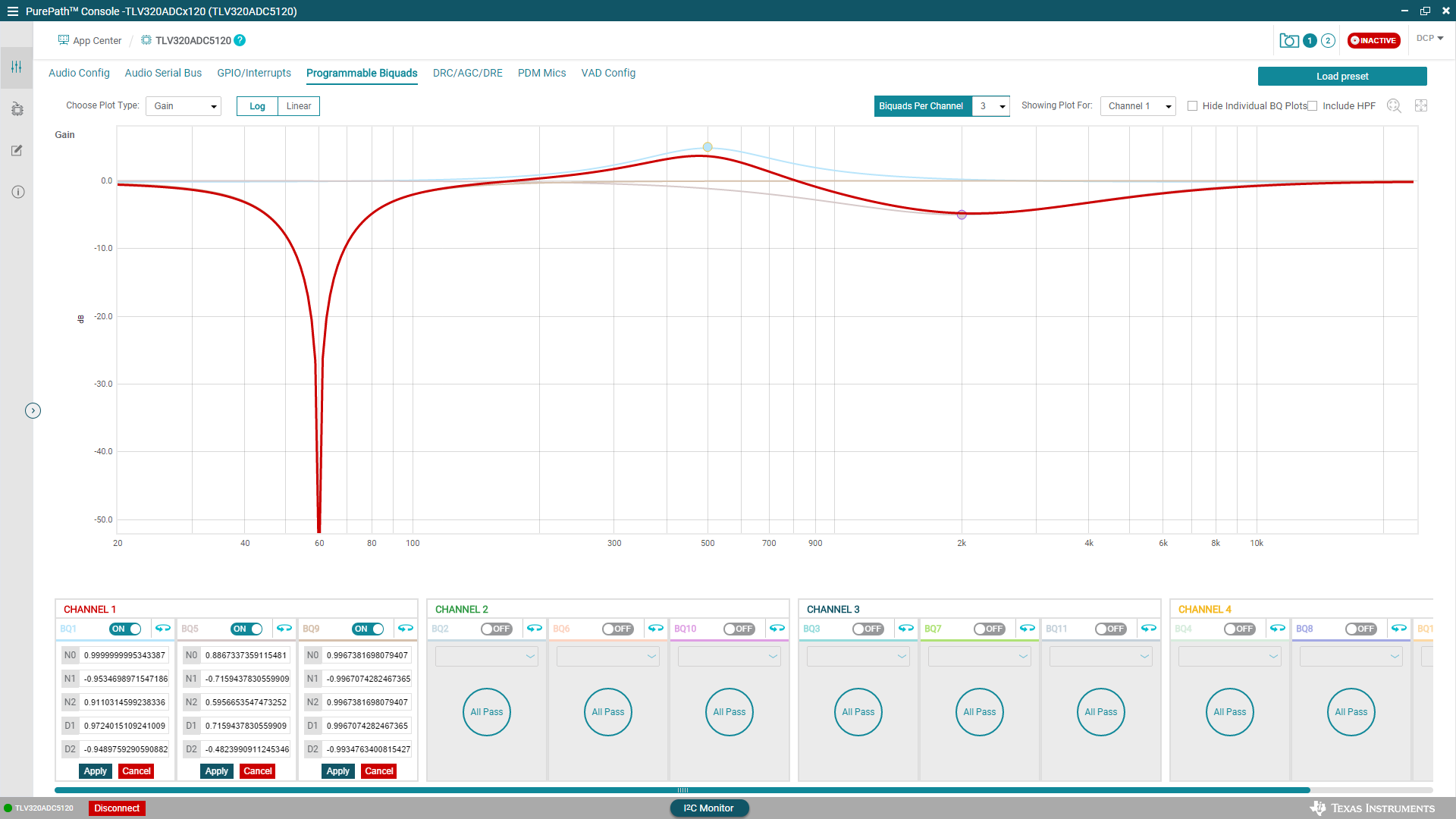SBAA497B May 2021 – April 2022 PCM3120-Q1 , PCM5120-Q1 , PCM6120-Q1 , TLV320ADC3120 , TLV320ADC5120 , TLV320ADC6120
- Trademarks
- 1Introduction
- 2Infinite Impulse Response Filters
-
3TLV320ADCx120 and PCMx120-Q1 Digital Biquad Filters
- 3.1 Filter Design Using PurePath Console
- 3.2 How to Generate N0, N1, N2, D1, and D2 Coefficients with a Digital Filter Design Package
- 3.3 Avoid Overflow Conditions
- 3.4 Digital Biquad Filter Allocation to Output Channel
- 3.5 Programmable Coefficient Registers for Digital Biquad Filters 1–6
- 3.6 Programmable Coefficient Registers for Digital Biquad Filters 7–12
- 4How to Program the Digital Biquad Filters on the TLV320ADCx120 and PCMx120-Q1
- 5Typical Audio Applications for Biquad Filtering
- 6Crossover Networks
- 7Voice Boost
- 8Bass Boost
- 9Removing 50 Hz–60 Hz Hum With Notch Filters
- A Digital Filter Design Techniques
- B Related Documentation
- B Revision History
3.1.1 Example Generating Programmable Biquad Coefficients Using PurePath Console
Figure 3-2 shows how to create a set of filters for 5-dB boost at 500 Hz with bandwidth of 400 Hz, cut –5 dB at 2 kHz with 3-kHz bandwidth, and a Notch filter at 60 Hz with 50-Hz bandwidth for channel 1. Note that each biquad filter is color-coded. The cyan color refers to BQ1 500-Hz equalizer, light gray to BQ5 2 kHz, and brown to BQ9 Notch filter at 60 Hz. The overall response of all three filters is plotted in red. Note that cutoff or center frequencies are marked on the graph to allow you to drag and move the center frequencies of the filters. The graphical plots allows users to zoom in and out of the frequency response plot and choose logarithmic or linear frequency axis, plot gain, phase, group delay, or impulse response.
 Figure 3-2 PurePath™ Console Programmable Biquad Filter Example
Figure 3-2 PurePath™ Console Programmable Biquad Filter ExampleClicking on the swivel arrow at each biquad shows the normalized floating point coefficients for N0, N1, N2, D1, and D2 of Equation 3, as shown in Figure 3-3. Note the PurePath Console has computed the floating point coefficients b0, b1, b2, a1, and a2 of Equation 2 and converted into the necessary values for N0, N1, N2, D1, and D2. Clicking the Apply button transmits the coefficients through I2C to the TLV320ADCx120 and PCMx120-Q1 devices on the EVM.
 Figure 3-3 PurePath™ Console Programmable Biquad Filter Example Showing the
Computed Coefficients in Normalized Floating Point Format
Figure 3-3 PurePath™ Console Programmable Biquad Filter Example Showing the
Computed Coefficients in Normalized Floating Point Format